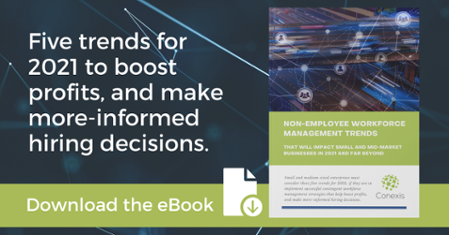Hiring temporary workers and independent contractors can be appealing for a number of reasons, whether it is to scale up your workforce quickly or to access hot skills on a temporary basis.
That’s why use of the contingent workforce has grown exponentially in recent years.
The problem is, most companies (especially those with smaller contingent workforce budgets) aren’t managing their non-employee workforce programs effectively.
A study from Deloitte, found that 37 percent of survey respondents expected growth in their use of contractors, 33 percent in the use of freelancers, and 28 percent in the use of gig workers - yet only 16 percent said they had established a set of policies and practices to manage this workforce.
To overcome the challenges posed by poor management, a vendor management system (VMS) is critical. By consolidating your vendor and non-employee workforce data in one centralized location, you’ll be able to discover actionable insights that answer some of your top contingent labour questions.
Before we dive into those questions, let’s first take a look at what a VMS actually is.
What is a vendor management system?
A vendor management system is a web or cloud-based software solution that allows your business to manage the entire contingent workforce vendor process in one centralized, and automated, location - giving you complete visibility of your program.
With the ability to give your hiring managers access to non-employee workforce data on any device that’s connected to the internet, a VMS allows your organization to manage the entire non-employee hiring and management process.
That includes everything from engaging your staffing agencies, sourcing independent contractors or temporary workers, onboarding non-employee workers, time entry, approval and invoicing.
On top of that, detailed reporting and consolidated vendor information gives your business the analytics it needs to measure the performance of staffing vendors from request to payment.
What contingent labour questions can a VMS help you answer?
Through consolidated vendors, improved program visibility and the ability to monitor and track vendor performance, a vendor management system gives your organization the opportunity to gain real insights that will improve workforce quality and reduce program spend.
Here are a few key questions that a VMS can help you answer, and in turn, improve the profitability of your business:
Why do we have non-employee turnover?
Turnover can be hugely expensive for any business. If your contingent workers aren’t finishing their contracts, it’s likely you have a larger issue at hand - but what exactly is that issue? The visibility you gain from the use of vendor management software can help you answer this question.
The data from a VMS will show exactly where in your non-employee workforce you are struggling with high turnover. You can use this data to explore the issue in more detail. Perhaps you aren’t paying market rates, maybe your staffing agencies aren’t fulfilling their promises or maybe you are targeting workers in the wrong location. There are a huge number of reasons why turnover could be high, and a vendor management system will help your business to pinpoint those reasons.
Want to learn more about how you can reduce turnover within your non-employee workforce program? Read our blog, 5 Ways to Reduce Turnover in Your Temporary Workforce.
Are we paying competitive, market rates?
The amount you pay for contingent workers has a huge affect on the overall health of your non-employee program. Overpaying can adversely affect your company’s profitability, while underpaying will result in lower workforce quality and increased turnover.
A vendor management system gives your business clear insight into whether you are paying more or less than the market rate for contingent workers. You can use this information to discover patterns among hiring managers, and build a company-wide strategy that will improve how you engage staffing agencies moving forward.
How are our staffing agencies performing?
An important aspect of a successful contingent workforce program is engaging the right staffing vendors. To ensure your staffing agencies are helping your organization achieve its workforce target, it’s crucial that you monitor and track their performance.
By using a vendor management system to monitor each stage of your non-employee workforce lifecycle, you will have visibility into important key performance indicators such as time-to-fill, time-to-submit and turnover.
Ultimately, a vendor management system gives your organization the visibility it needs to make smarter decisions about your non-employee workforce. This results in improvements in workforce quality, efficiency gains and significant cost savings.
Want to learn more about how a VMS can improve your contingent workforce program over the time-consuming and manual spreadsheets that many companies use? Contact Conexis VMS today. We’re ready to help.




